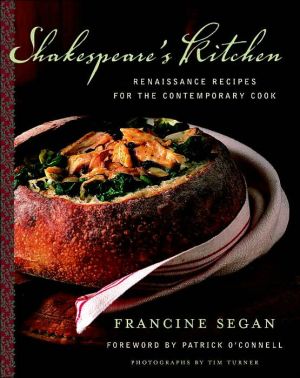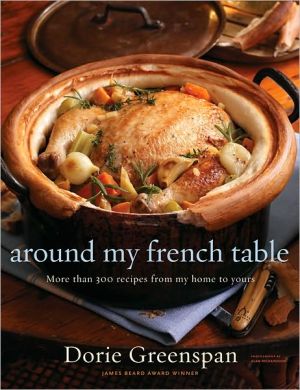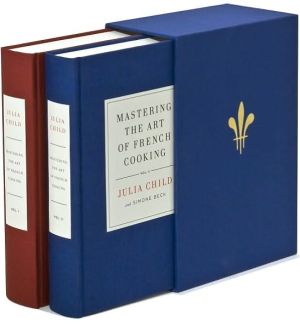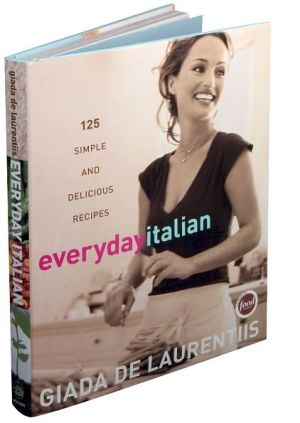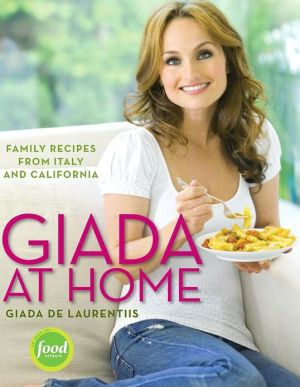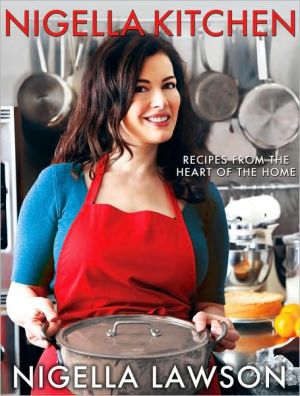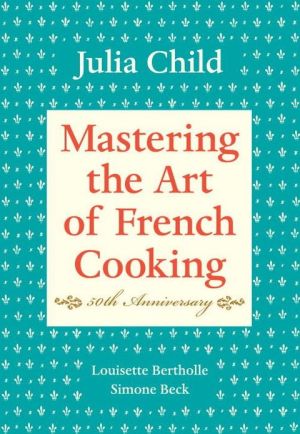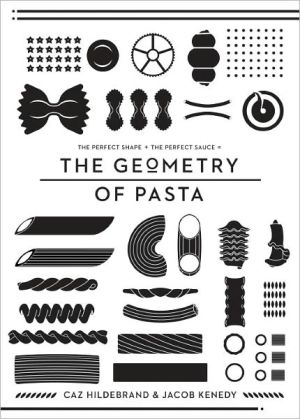Shakespeare's Kitchen: Renaissance Recipes for the Contemporary Cook
“Shakespeare’s Kitchen not only reveals, sometimes surprisingly, what people were eating in Shakespeare’s time but also provides recipes that today’s cooks can easily re-create with readily available ingredients.”\ —from the Foreword by Patrick O’Connell\ Francine Segan introduces contemporary cooks to the foods of William Shakespeare’s world with recipes updated from classic sixteenth- and seventeenth-century cookbooks. Her easy-to-prepare adaptations shatter the myth that the Bard’s primary...
Search in google:
“Shakespeare’s Kitchen not only reveals, sometimes surprisingly, what people were eating in Shakespeare’s time but also provides recipes that today’s cooks can easily re-create with readily available ingredients.”—from the Foreword by Patrick O’ConnellFrancine Segan introduces contemporary cooks to the foods of William Shakespeare’s world with recipes updated from classic sixteenth- and seventeenth-century cookbooks. Her easy-to-prepare adaptations shatter the myth that the Bard’s primary fare was boiled mutton. In fact, Shakespeare and his contemporaries dined on salads of fresh herbs and vegetables; fish, fowl, and meats of all kinds; and delicate broths. Dried Plums with Wine and Ginger-Zest Crostini, Winter Salad with Raisin and Caper Vinaigrette, and Lobster with Pistachio Stuffing and Seville Orange Butter are just a few of the delicious, aromatic, and gorgeous dishes that will surprise and delight. Segan’s delicate and careful renditions of these recipes have been thoroughly tested to ensure no-fail, standout results.The tantalizing Renaissance recipes in Shakespeare’s Kitchen are enhanced with food-related quotes from the Bard, delightful morsels of culinary history, interesting facts on the customs and social etiquette of Shakespeare’s time, and the texts of the original recipes, complete with antiquated spellings and eccentric directions. Fifty color images by award-winning food photographer Tim Turner span the centuries with both old-world and contemporary treatments. Patrick O’Connell provides an enticing Foreword to this edible history from which food lovers andShakespeare enthusiasts alike will derive nourishment. Want something new for dinner? Try something four hundred years old. Publishers Weekly According to food historian Segan, we inherited much of what we now think of as "American" food from the English: "The Pilgrims who arrived at Plymouth Rock were Shakespeare's contemporaries and they brought their cookbooks from England." Updating dozens of classic Elizabethan recipes, Segan leads a culinary foray into Shakespeare's time. Each recipe is supplemented with a historical note that places the dish in context. For instance, Individual Meat Pies with Cointreau Marmalade were served by vendors catering to the theater crowd. The recipes have been adapted for the modern kitchen: all references to cauldrons have been removed. Section titles are in period English (Kickshaws instead of Appetizers, Fysshe instead of Fish, Pottage instead of Soups), but Renaissance scholars are not the only readers who will get a kick out of this book. Its playful tone, fascinating side-notes, and apt citations from the Bard's plays make this book as fun to read as it is to cook from. And for the person who spends time in the kitchen hoping to satisfy curiosity as well as appetite, recipes like Lemony Sweet Potatoes with Dates and Lobster Tails with Wildflowers are sure to appeal. Photos not seen by PW. (Oct.) Forecast: The collection is sure to be a hit in college towns and at Renaissance Faires. Copyright 2003 Reed Business Information.
“Shakespeare’s Kitchen not only reveals, sometimes surprisingly, what people were eating in Shakespeare’s time but also provides recipes that today’s cooks can easily re-create with readily available ingredients.”\ —from the Foreword by Patrick O’Connell\ Francine Segan introduces contemporary cooks to the foods of William Shakespeare’s world with recipes updated from classic sixteenth- and seventeenth-century cookbooks. Her easy-to-prepare adaptations shatter the myth that the Bard’s primary fare was boiled mutton. In fact, Shakespeare and his contemporaries dined on salads of fresh herbs and vegetables; fish, fowl, and meats of all kinds; and delicate broths. Dried Plums with Wine and Ginger-Zest Crostini, Winter Salad with Raisin and Caper Vinaigrette, and Lobster with Pistachio Stuffing and Seville Orange Butter are just a few of the delicious, aromatic, and gorgeous dishes that will surprise and delight. Segan’s delicate and careful renditions of these recipes have been thoroughly tested to ensure no-fail, standout results.\ The tantalizing Renaissance recipes in Shakespeare’s Kitchen are enhanced with food-related quotes from the Bard, delightful morsels of culinary history, interesting facts on the customs and social etiquette of Shakespeare’s time, and the texts of the original recipes, complete with antiquated spellings and eccentric directions. Fifty color images by award-winning food photographer Tim Turner span the centuries with both old-world and contemporary treatments. Patrick O’Connell provides an enticing Foreword to this edible history from which food lovers and Shakespeare enthusiastsalike will derive nourishment. Want something new for dinner? Try something four hundred years old. \ Author Biography: Francine Segan is a psychologist, writes and lectures on food history, and consults on historic menu planning. Segan, her husband, Marc, an inventor and theater producer, and their two children, Samantha and Max, divide their time between New York City, the Berkshires, and Italy.
\ Publishers WeeklyAccording to food historian Segan, we inherited much of what we now think of as "American" food from the English: "The Pilgrims who arrived at Plymouth Rock were Shakespeare's contemporaries and they brought their cookbooks from England." Updating dozens of classic Elizabethan recipes, Segan leads a culinary foray into Shakespeare's time. Each recipe is supplemented with a historical note that places the dish in context. For instance, Individual Meat Pies with Cointreau Marmalade were served by vendors catering to the theater crowd. The recipes have been adapted for the modern kitchen: all references to cauldrons have been removed. Section titles are in period English (Kickshaws instead of Appetizers, Fysshe instead of Fish, Pottage instead of Soups), but Renaissance scholars are not the only readers who will get a kick out of this book. Its playful tone, fascinating side-notes, and apt citations from the Bard's plays make this book as fun to read as it is to cook from. And for the person who spends time in the kitchen hoping to satisfy curiosity as well as appetite, recipes like Lemony Sweet Potatoes with Dates and Lobster Tails with Wildflowers are sure to appeal. Photos not seen by PW. (Oct.) Forecast: The collection is sure to be a hit in college towns and at Renaissance Faires. Copyright 2003 Reed Business Information.\ \ \ \ \ Library JournalBritish food, renowned for its lack of appeal, provokes gentle chortles of derision when mentioned in juxtaposition with a word like extraordinary. These two books disabuse readers of the notion that this has always been the case. British Food describes the glories-and the decline-of the nation's cuisine over the centuries, while Shakespeare's Kitchen translates a particular era for modern cooks. Spencer, former food editor of the Guardian and author of several cookbooks, intriguingly suggests that early modern British cooking was more influenced by Mediterranean and Arab fare than French. For example, the technique of cooking with almonds to create white dishes was the gift of returning Crusaders. Spencer traces the country's lamentable decline in cuisine through the Reformation, Puritanism, and the Industrial Revolution, noting that Britons gradually lost a knowledge of wild foodstuffs and the time in their day to gather and cook more than the most convenient foods. Modern Britons would not recognize the impressive lists of ingredients their ancestors used. Readers may, thus, find the glossary and appendixes of British edible flora and traditional dishes to be particularly valuable. Segan, a food historian and contributor to the New York Food Museum, offers a lavishly illustrated cookbook that goes beyond the usual ingredients and step-by-step instructions. Drawn in by a photograph, readers will not only encounter a tempting recipe but also an accompanying text on the provenance of the dish and how it was modernized. Better still, Segan frequently offers the original recipe from Elizabethan texts, allowing one to compare the styles of written recipes. Name-dropping Shakespeare is a marketing gimmick, perhaps, for while the recipes include quotations from the Bard, the book is about Elizabethan cooking, not food from Shakespearean works. The reader who has first enjoyed Spencer's book will recognize much found in Segan's book and likely appreciate it all the more. British Food would fit well in academic and public libraries for its unique view of British history, while Shakespeare's Kitchen is recommended for public libraries.-Peter Hepburn, Univ. of Illinois at Chicago Lib. Copyright 2003 Reed Business Information.\ \
